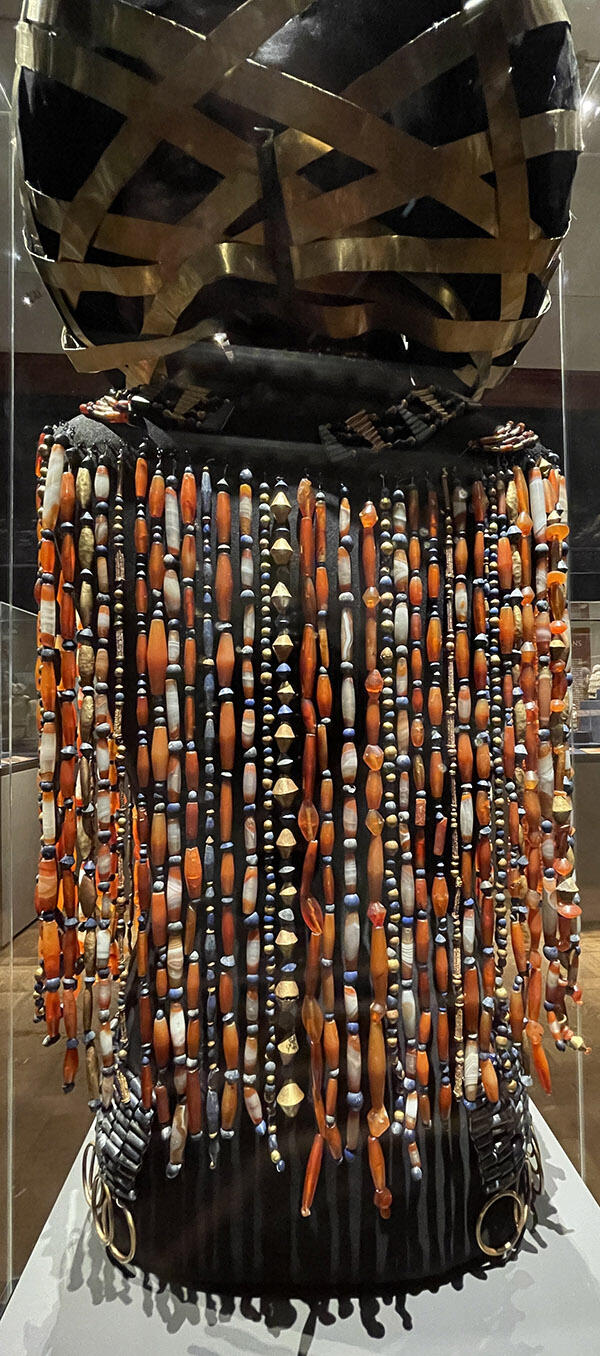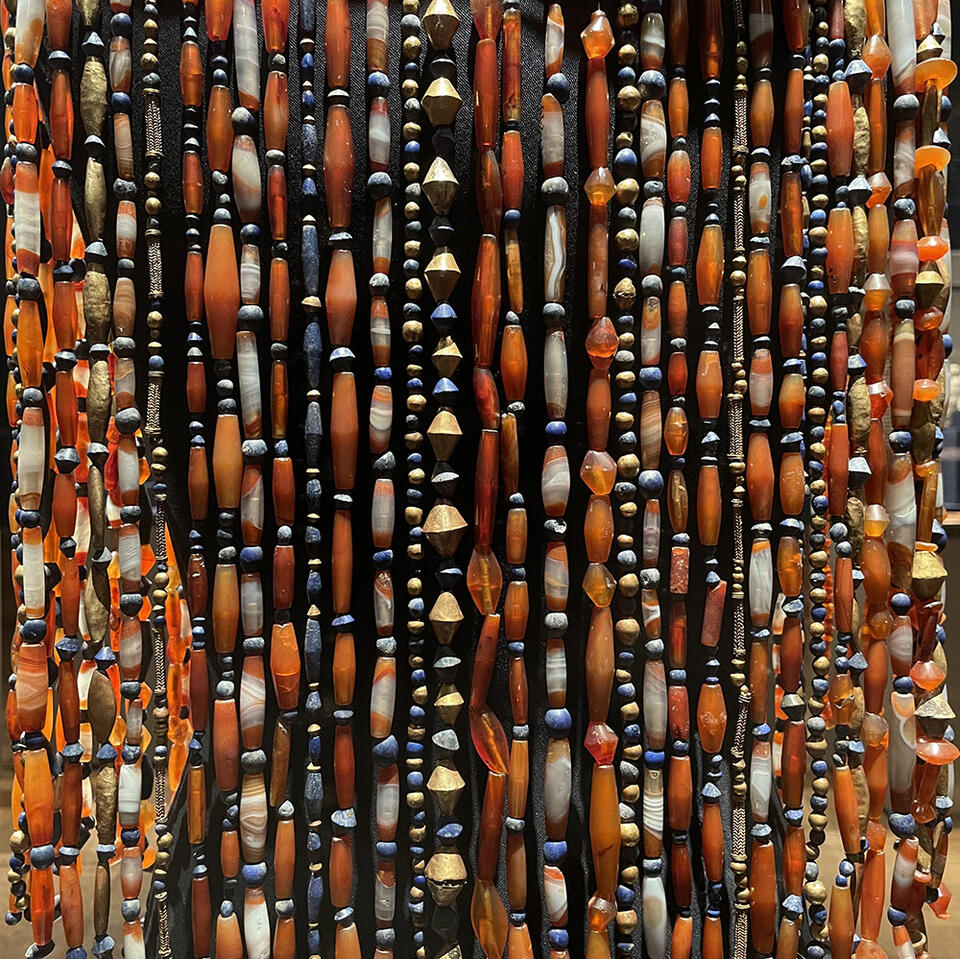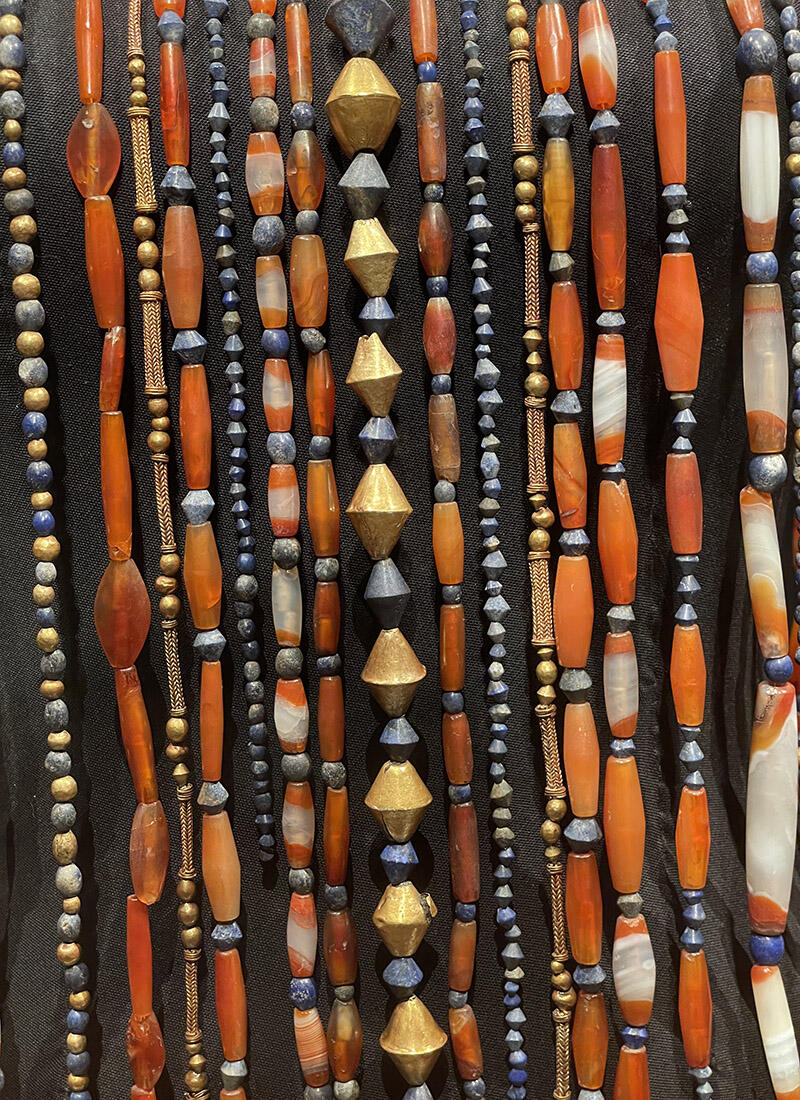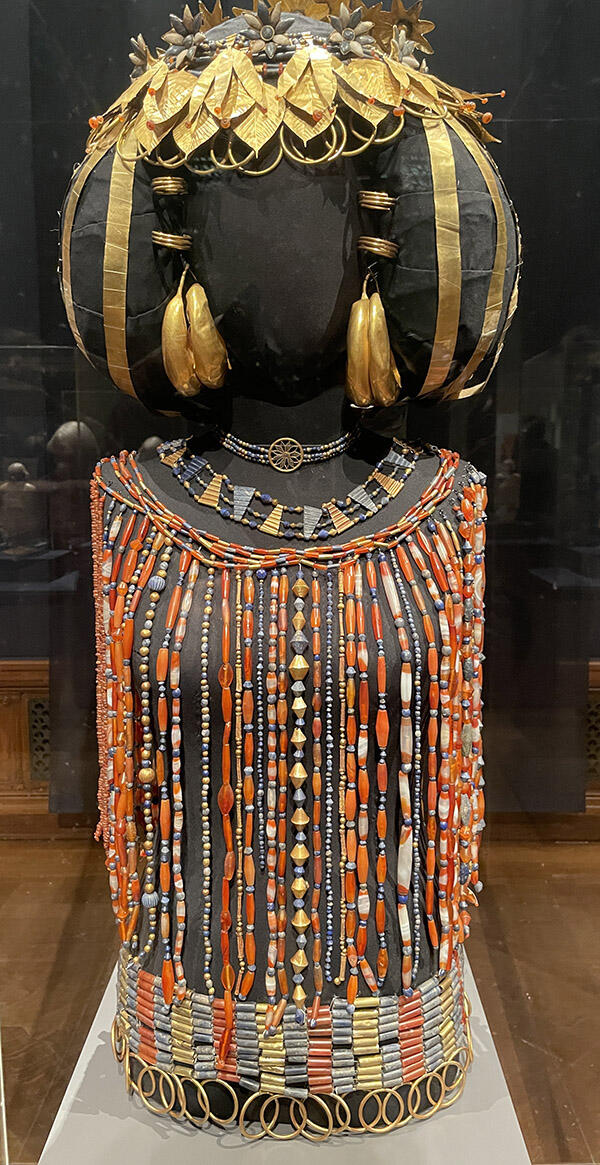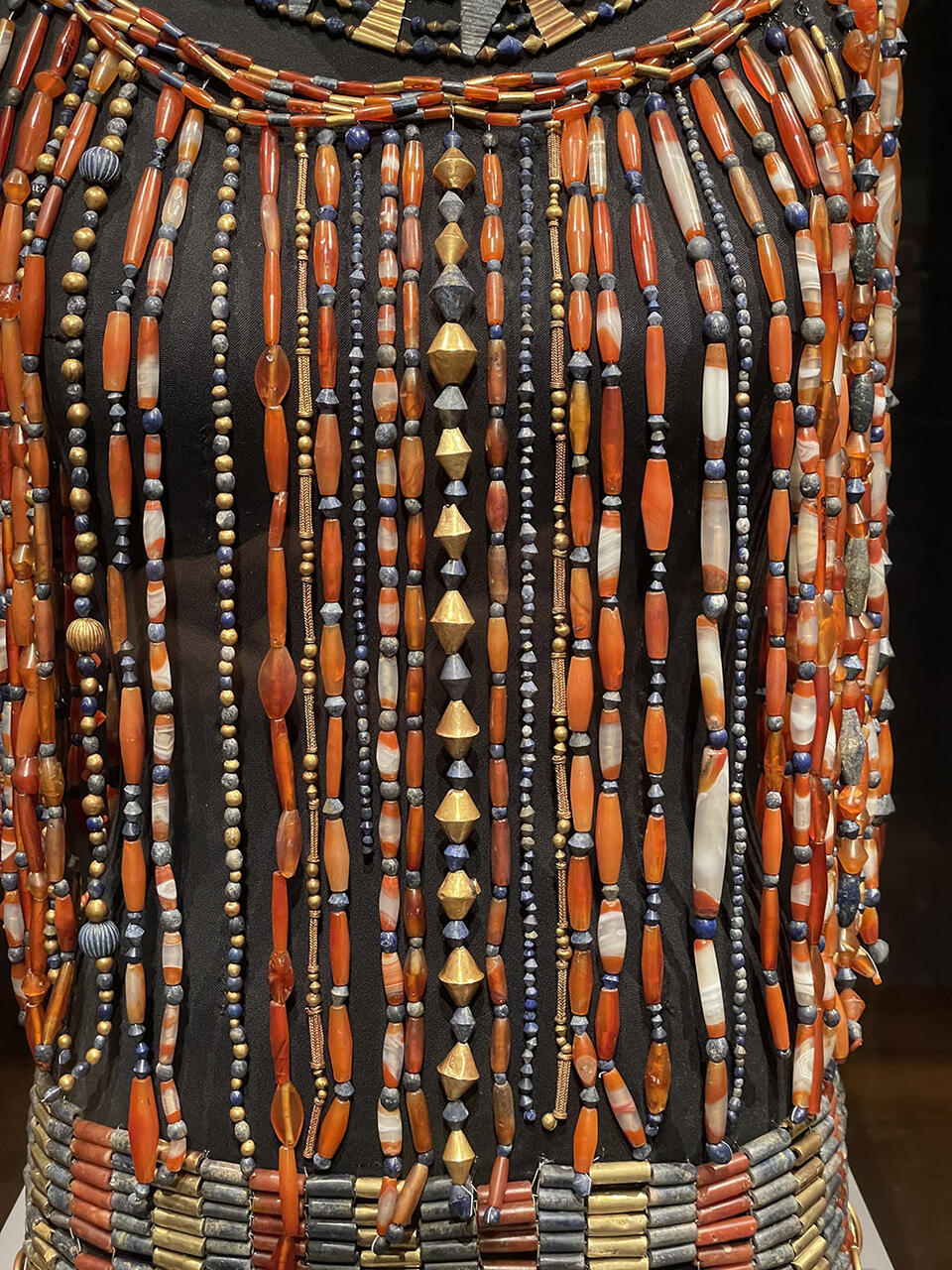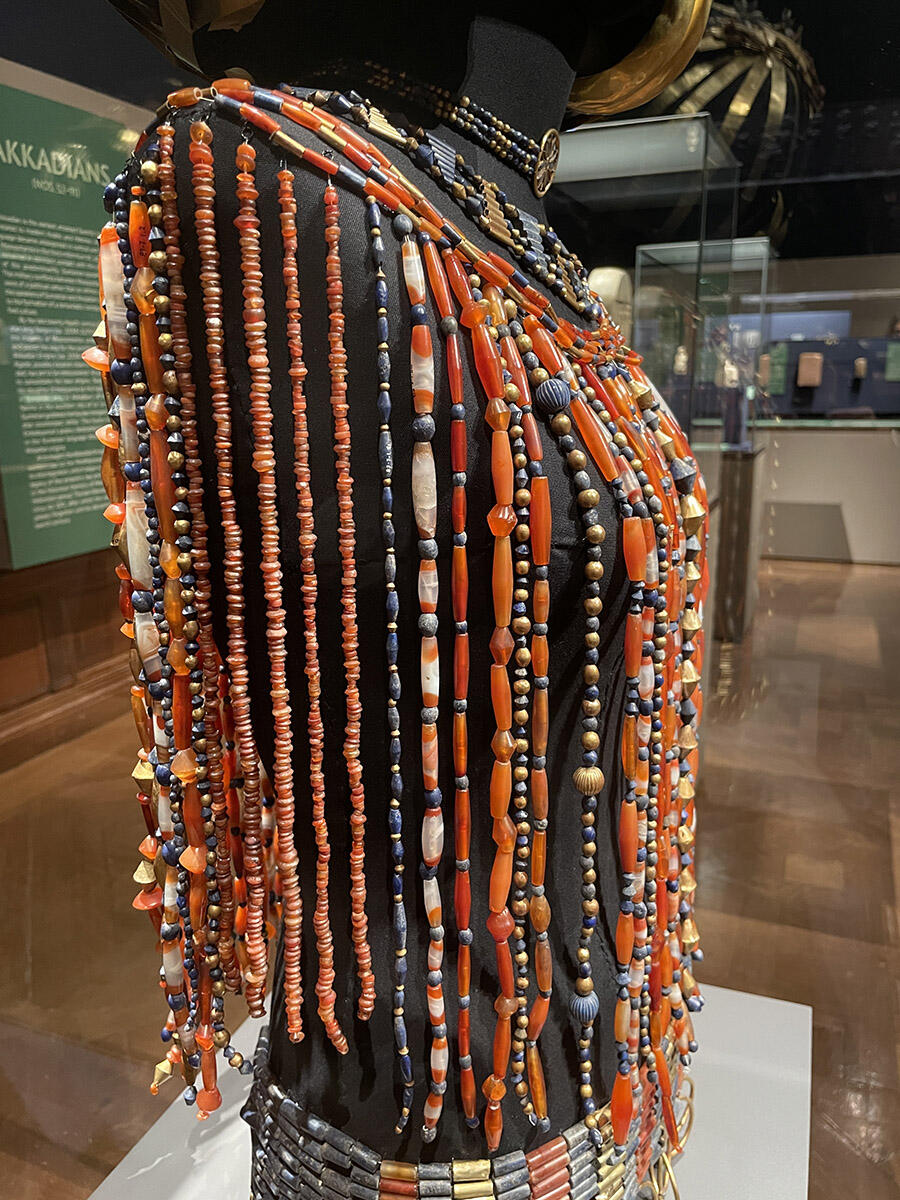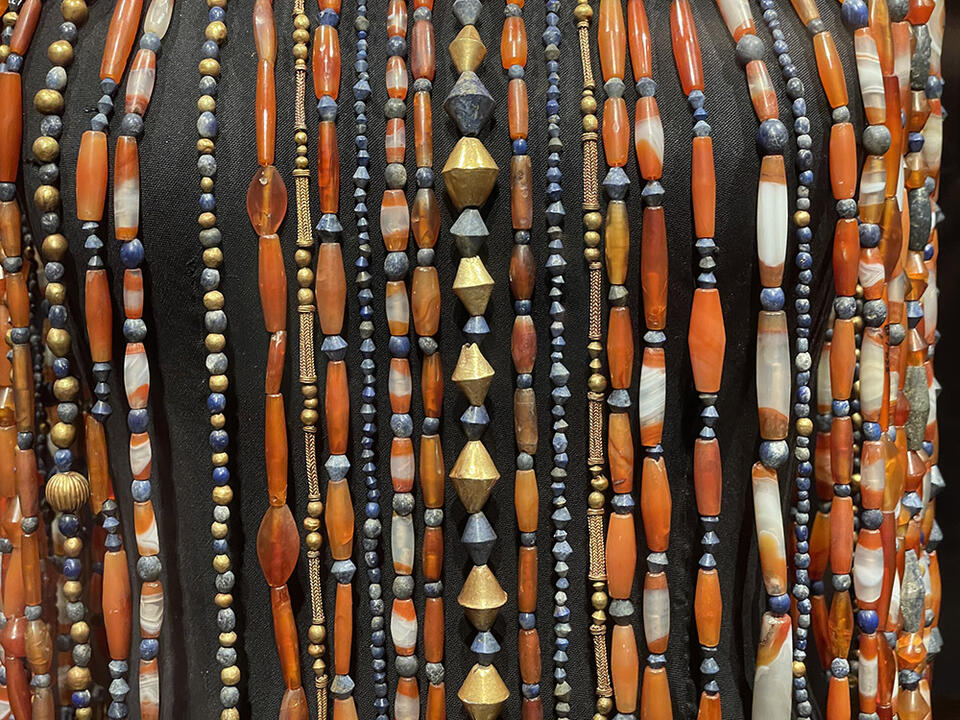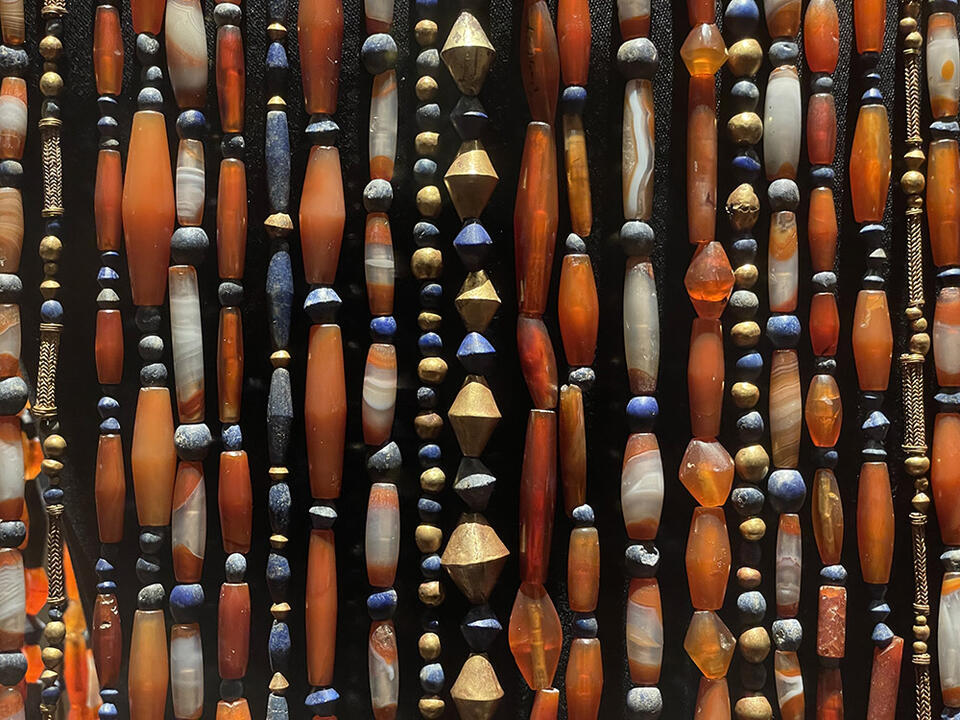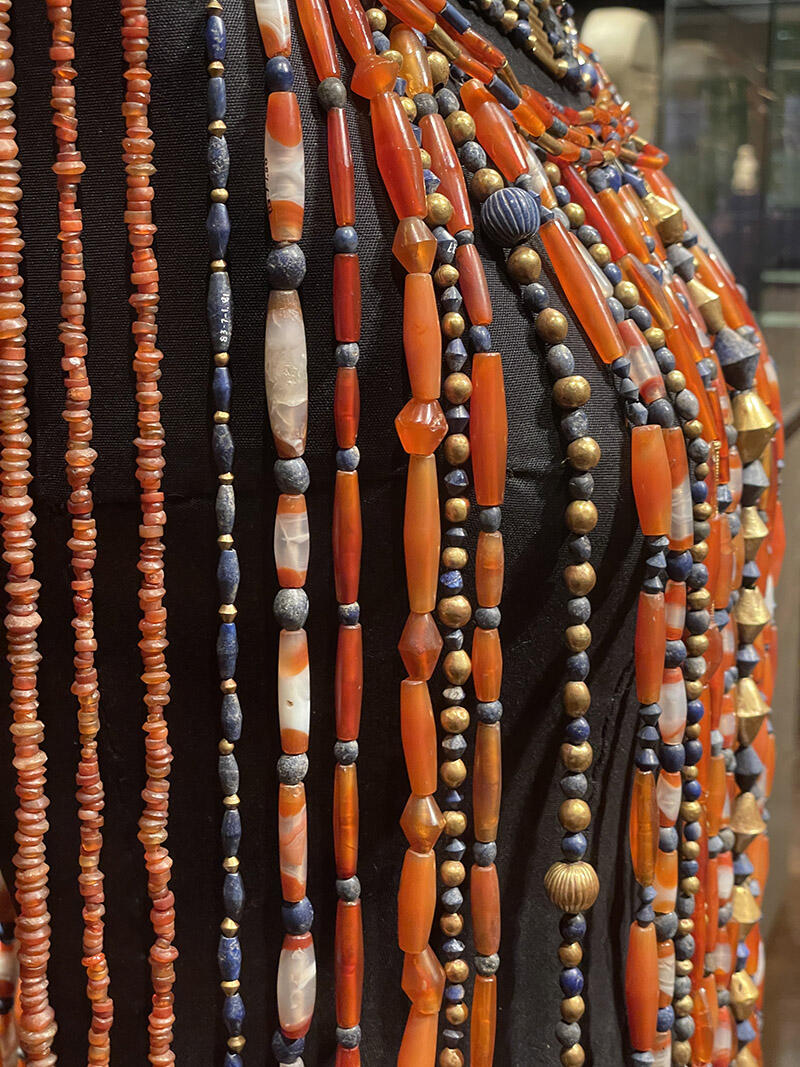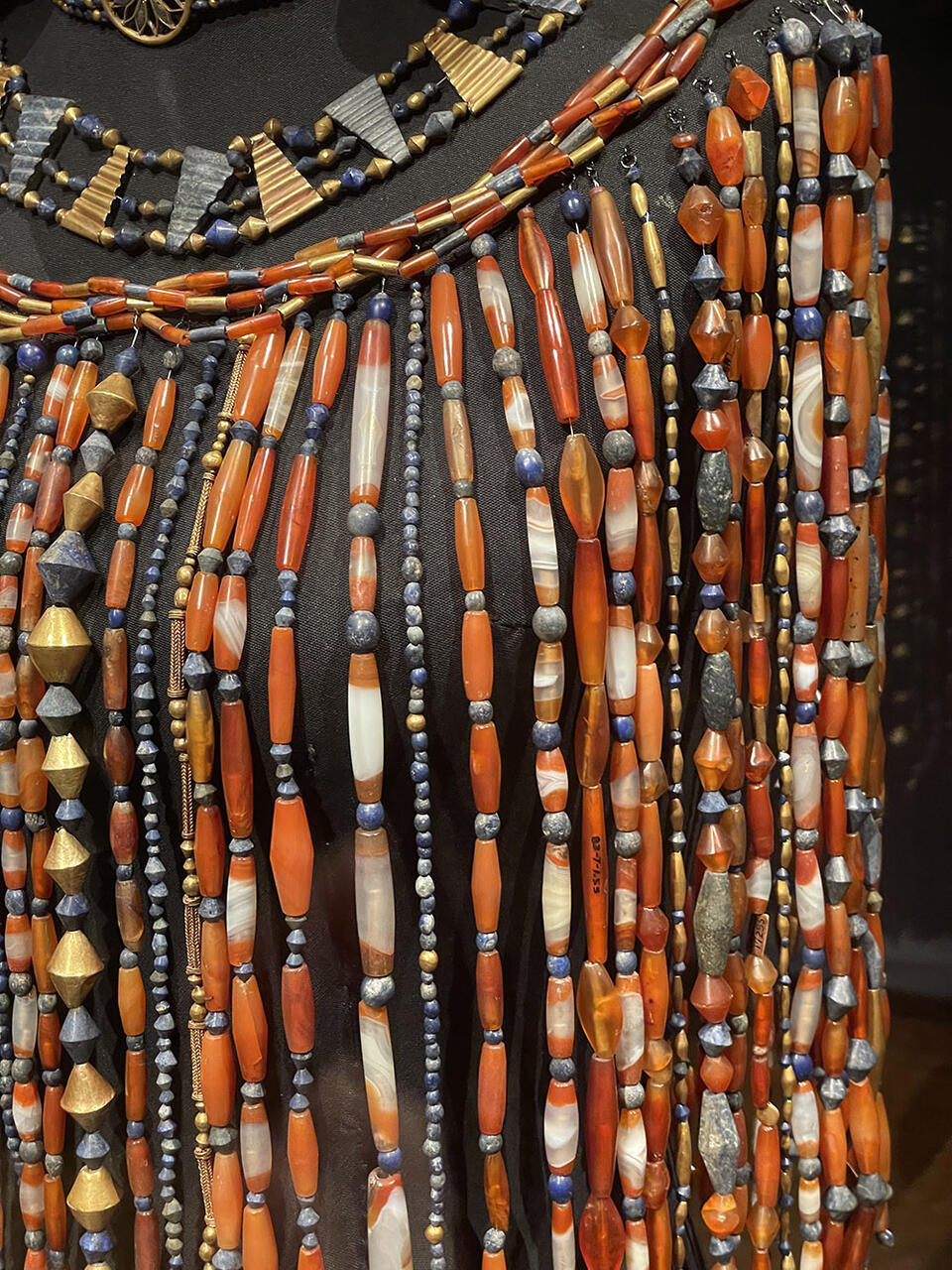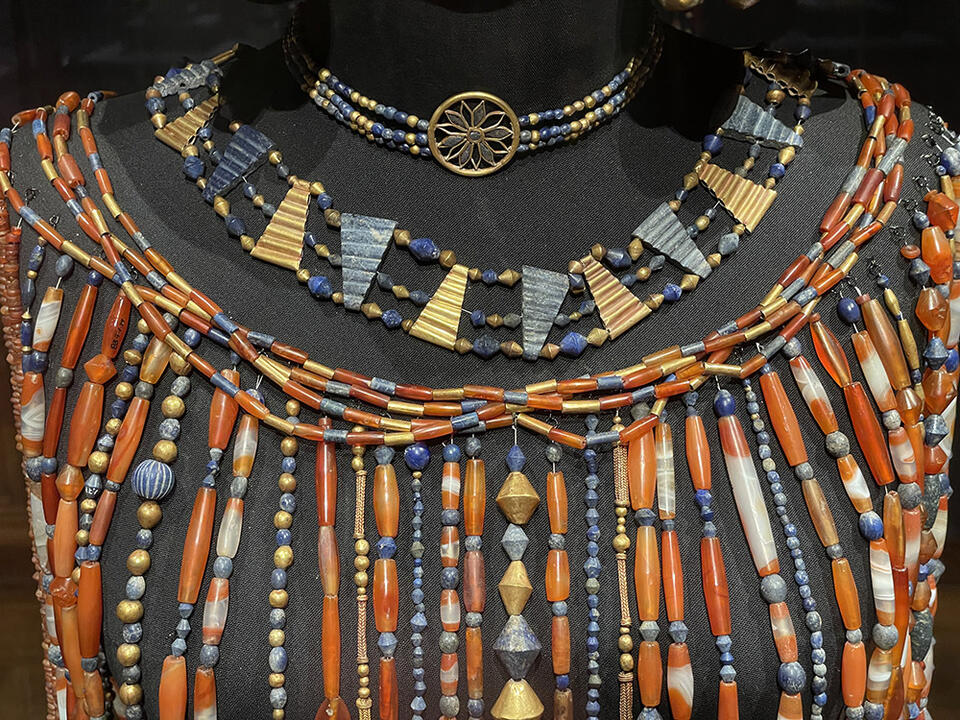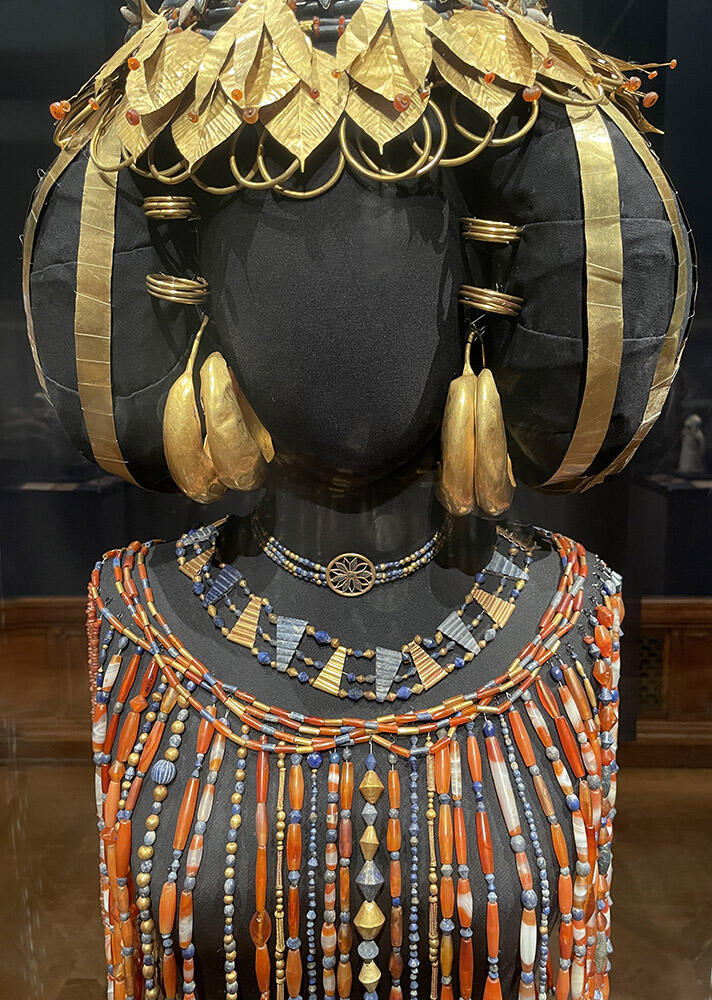January 2nd, 2023
It is ironic that what is possibly one of the most spectacular examples of Indus craftsmanship and artistry was found not at Mohenjo-daro or Harappa, or even in the subcontinent, but in ancient Mesopotamia. There is even a rough date when it was assembled – around 2500 BCE – and for whom: Queen Puabi of the city of Ur. When she died, her burial shroud was made of so much carnelian, lapis, gold and agate that it leaves us as breathless today as it must have to its beholders then, and most certainly was in 1927 when it was discovered and compared to the discoveries at Tutankhamun’s tomb earlier in the decade. Although it helped launch the field of Mesopotamian discoveries, sadly it has not received the attention that it might have since then. The recent complete presentation at the Morgan Library in New York during the exhibition She Who Wrote on women, seals and writing in ancient Mesopotamia is a boon to Indus enthusiasts too. (The original is held by the University of Pennsylania Museum of Anthropology and Archaeology in Philadelphia, which led the 1926/27 excavations at Ur.)
We know little about Queen Puabi. Her seals, two of which are also at the exhibition, name her outright, without a man’s name appended as was typically the case on these tokens of identity. She died at the age of forty. Her internment, with this magnificent shroud, also “involved the ritual execution of many soldiers, musicians and servants,” according to the Morgan’s guide. The event, if not the jewels, was bathed in blood.
What is truly remarkable though is how much a Queen at the time was honored with the manufacture and materials representative of another culture. While the Puabi beads in particular have not yet been properly studied, according to Dr. Jonathan Mark Kenoyer, "many of the long barrel red carnelian were probably made in the Indus or made by Indus craftspeople in Mesopotamia. The lapis lazuli beads were made using imported stone in Mesopotamia. The other banded agates also may have been made from raw materials from different regions but crafted either locally or brought in finished form to Mesopotamia. None of the materials in the beaded cloak are local from Mesopotamia."
As Dr. Mark Kenoyer wrote in his article Trade and Technology of the Indus Valley (1997): "By using high definition analysis of drilling technology it has been possible to define more specific relationships between the technology and manufacturing processes of the Indus Valley and beads found outside of the Indus region. Detailed comparison between Indus drilling and the drill holes on long carnelian beads recovered from the excavations of the royal burials at Ur have confirmed that many of the beads from the Ur burials were made with the same technique as was found at the sites of Chanhudaro, Mohenjo daro and Harappa (Figure 6). Stylistically and morphologically these beads fall within the range of variation found in workshops of the Indus Valley and it is most likely that these beads were made in the Indus valley. However, some of the long carnelian beads and shorter bleached carnelian beads may have been produced in Mesopotamia in unique forms for Mesopotamian elites (Bhan, Vidale and Kenoyer 1994). Given the rarity of ernestite drills in the Indus valley itself, it is not unlikely that this ancient drilling technology was a closely guarded trade secret, and that these beads were made by migrant Indus artisan residing in Mesopotamia around 2600 B. C. These artisans may have been ancestors of the so-called Melluhan minority that are documented in Akkadian texts, from 2350-2200 B. C. (Parpola, Parpola and Brunswig 1977).
"By looking more closely at the context of these beads it is possible to take this investigation one step further. Most of the long carnelian beads from Ur were found with serving ladies sacrificed outside of the tomb of the queen Pu-abi (Woolley 1955). These ladies were wearing golden flower headdresses that have been compared with unique terra cotta figurines found only in the Indus valley and primarily at the site of Harappa (During-Caspers 1994). If some entrepreneurial Indus merchants and artisans were traveling to and residing in Mesopotamian cities, it is not impossible that musicians and performers, or serving ladies were also present in courts of the rulers. The association of Indus beads with these serving ladies and the similarities of their headdresses with Indus style hair ornaments is sufficient evidence to warrant a detailed comparison of their dental characteristics (most of the other skeletal remains are not preserved) with women from Indus cities such as Harappa. Such a study would be able to determine if there is any genetic relationship between these specific women and it could shed new light on the murky waters of international relations between the Indus Valley and Mesopotamia at this early time (Chakrabarti 1990)" (p. 272).
In a later article (Indus and Mesopotamian Trade Networks: New Insights from Shell and Carnelian Artifacts, 2008), he writes of the work of himself and Dr. Kuldeep Bhan on a bead from one of the male headdresses found next to Queen Puabi's burial: "We were able to study one of the largest examples of this type of carnelian bead at the University of Pennsylvania Museum (B 16792.1, length 61.54 mm) and determined that it was drilled using a distinctive Indus technique. This type of drilling involved the use of the Ernestite constricted cylindrical drill that has only been found at sites such as Mohenjodaro, Harappa and Chanhudaro. However, the shape of this bead is not Harappan and no such bead has ever been found in any Indus site. Nodules of long carnelian are not reported from any of the agate producing regions of Egypt or West Asia and therefore this raw material most probably originated in the Ratanpur deposits of Gujarat (Potts 1997).
"The production of this specific bead and perhaps many other shorter versions appears to have been directed specifically for the Mesopotamian market. Beads broken during manufacture or even good quality beads are often found in the sites where specialized production is going on. Since no beads of this type have been found in the Indus production sites, it is assumed that they were being produced in Mesopotamia. Since the production of long carnelian beads and the use of Ernestite drills was controlled in the Indus, it is unlikely that these techniques would have diffused to Mesopotamian craftsmen. In other words, the access to high quality raw material, along with the technology needed to flake, grind, heat and drill beads suggests that actual Indus bead makers were living somewhere in Mesopotamia.
"It is unlikely that specialized craftsmen would have been able to finance long distance travel and maintain access to distant raw materials for beads and drills. On the other hand, if specialized craftsmen were brought to Mesopotamia by entrepreneurial merchants to produce commodities for local trade this would indicate a highly developed system of long distance trade. In order to bet- ter understand the nature of the Indus-Mesopotamia bead trade it is necessary to undertake specially focused survey and excavation. Extensive surface surveys at Mohenjodaro revealed the presence of numerous craft activity areas (Vidale & Balista 1988; Pracchia, Tosi & Vidale 1985) and it is not unlikely that similar discoveries would be possible at Ur. Manufacturing debris of short carnelian beads was found in the debris sealing the royal cemetery (Woolley 1934), but there is no debris from the manufacture of long carnelian beads. If long carnelian beads were being made at the site, the bead makers were probably living in a separate craft area or possibly even in a distinct settlement" (pp. 25-26).
The Morgan’s accompanying text describes the whole ensemble nicely, but misses reference to any potential Indus connections. It is hard to believe that other similar beads from male headdresses near Queen Puabi's burial were made using Indus techniques, and these were not. It was likely that things from foreign climes, particularly Meluha, carried real value, enormous value in fact. For those who know however, there may be no better way to enjoy the full and varied glories of Indus bead innovation and craftsmanship: “Puabi’s funerary ensemble is a feast for the eyes with its vibrant colors, precious materials, and skilled artisanship. Several wreaths formed of floral and vegetal motifs once resented on her forehead. Ribbons of thinly hammered gold would have circled her voluminous hair. At the crows of her head sat a large gold comb, featuring seven delicately curving flowers. Large lunate earrings dangled from her ears, and gold coins from her hair. These radiant accessories would have formed a halo around Puabi’s face. Below, a choker with a central rosette sat against her neck. A profusion of carnelian, lapis lazuli, and gold beads covered her chest, strung in rhythmic patterns. Finally, a belt of beads with a fringe of disks would have rested against Puabi’s hips.”

